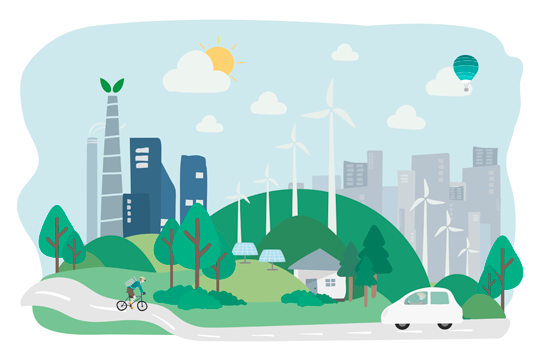Author: Yajing Zhou, Zhiming Pan and Clare Auld-Brokish
 Image by freepik
Image by freepik
Carbon emissions generated in China have reached approximately 7 tons per capita. This itself is cause for alarm, however a recent report by Carbonstop, a Chinese company specializing in carbon emissions research, estimates that there is substantial potential for megacity residents in China to reduce annual carbon emissions by more than 1 ton per person if they adopt a low-carbon lifestyle. To achieve its national “3060” goal (to peak carbon emissions in 2030 and to achieve carbon neutrality by 2060), it is important for China to promote low carbon lifestyles among its urban citizens in addition to its continued efforts to accelerate the transition to cleaner modes of energy production.
To explore effective mechanisms for promoting individual low-carbon consumption, NRDC released a report on April 27 entitled, “Case Studies on Projects Developed by Local Governments and Enterprises to Promote Individual Low-carbon Consumption in China.” The report introduced and analyzed the efforts of local governments, including those in the major metropolitan areas of Wuhan, Shenzhen, Nanjing, Beijing, Chengdu, Shanghai, and Guangdong Province, and leading enterprises to promote low carbon consumption among individuals. The following paragraphs summarize the major insights and conclusions of NRDC’s research.
Strengths and weaknesses of projects led by local governments and enterprises
Most of the projects led by local governments to encourage low-carbon behaviors have adopted carbon credit systems. The Wuhan government, for example, set up Tanbaobao, a “carbon wallet” program in which an individual’s low-carbon actions are evaluated and the corresponding carbon emissions reductions are awarded as credits. Individuals may then exchange these credits for everyday items like toiletries, phone cards, etc. Alternatively, many enterprises have developed low-carbon products or services within their original scope of business to promote low-carbon consumption. Examples include carpooling services, eco-friendly takeout products, and recyclable delivery packages. Some enterprises visualize low-carbon behaviors using captivating animations on mobile apps to increase engagement and participation from consumers. A great example is the use of virtual trees and cartoon animations in the widely popular Ant Forest app to reflect the adoption of real-world behaviors that lower an individual’s carbon impact. Other enterprises have found innovative methods for motivating the adoption of specific types of low-carbon behaviors like ClearPlate, a WeChat mini program that encourages people to mitigate food waste.
Projects developed by local governments and enterprises have separate operational goals which makes their impacts significantly different. The former tends to have higher credibility among individuals. However, as most of these projects are not profit-oriented and only aim to reduce carbon emissions or mitigate other environmental issues, they are often difficult to maintain over a long period of time. In contrast, making a profit is intrinsic to enterprise-initiated projects while promoting environmentally friendly behaviors is a positive by-product. With more mature business models, these projects are more easily able to maintain stable operations and sustainability efforts in the long run.
One such example was a city government’s initiative to combat rampant exhaust emissions. The aim of the city-led public project was to reduce air pollution by incentivizing increased ridership of low-carbon transport. To encourage participation and lower the cost of operation, the city funded the development of a WeChat mini program with a carbon credit system that rewarded individuals who took public transportation. At the same time, the project expanded its scope and began to widely promote a large set of low-carbon daily activities. The project operated for two years, during which it had continuous difficulty making a profit. In the end, it could not sustain itself after the government withdrew its funding during a round of budget cuts.
As Yuan Cao, the developer of Tanbaobao, Wuhan’s carbon credit system, pointed out, in a society where mobile payment and a sharing economy are so common and so involved in almost every aspect of life, consumers are more likely to choose convenience and reward over the opportunity to reduce carbon emissions or even to promote public interests. Therefore, large investments in bonuses and incentives are required to attract and retain users. Government projects that lack the capital and incentives for commercial investment are often short-lived because they cannot compete with well-funded enterprise projects that provide similar services.
The “3060” goal has accelerated public and private sector emissions reduction action
In September 2020, President Xi Jinping announced China’s “3060” goal at the UN General Assembly. This provided cities and enterprises the impetus to take a broad range of emissions reduction actions. In the months since, more than half of China’s provinces and municipal governments have already incorporated research on strategies to peak carbon emissions into their work plans. Notably, the Shanghai government included its strategy to peak carbon emissions by 2025 in its 14th Five-Year Plan, released in early 2021, and the Beijing government has pledged to release a carbon neutrality action plan later this year.
In addition to its effect on local governments, the “3060” goal has instigated a notable shift in the attitudes of China’s enterprises towards emissions reduction. The team at NRDC communicated with several enterprises while compiling its report and was able to experience this transformation as it occurred. One of these enterprises was a leading company in the food delivery industry. Although the company had already developed many environmentally friendly initiatives, including promoting eco-friendly delivery packages, reducing the usage of disposable tableware, and saving energy in its office buildings, it had never taken a greenhouse gas inventory or assessed the emissions reduction impacts of these actions before the announcement of the “3060” goal. In the time since, the company has begun work on carbon accounting in preparation for setting its own peak emissions goals.
Building a multi-stakeholder collaboration network to promote low-carbon consumption
To make full use of the advantages of various stakeholders and to capitalize on the enormous potential of individual behaviors to help achieve the “3060” goal, NRDC proposes the development of a multi-stakeholder collaboration network to promote individual low-carbon consumption in China.
The proposed network would bring together NGOs as the initiators, enterprises as the operators, and local governments as the supporters with the mission of encouraging more enterprises to develop a greater variety of low-carbon products and services, and fine-tuning incentive structures for individual behaviors. The network would work with stakeholders to develop a scientific standard of carbon accounting to ensure that the same behaviors are evaluated in a uniform way across cities and enterprises. It would also identify and collaborate with early adopters of the low-carbon lifestyle and motivate others to join them by promoting their experiences as pioneers. Together, these efforts would galvanize stakeholders to collaborate and create a robust market for low-carbon consumption in China and empower individuals to help the whole country achieve its carbon neutrality goals.


